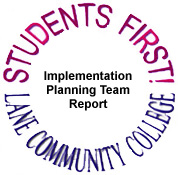| Lane Home Page | Search Lane |
| Website Accessibility |
|
Table of Contents | Students First! Page This chapter describes the factors that the Students First! Implementation Planning Team used to prioritize the individual recommendations. The factors considered are impact, complexity, resource requirements, interdependencies, and timeframe. A summary of the results of the prioritization analysis and a discussion of the implications of the results are included. Prioritization Factors Impact Defined in terms of the number of students and employees affected by the recommendation, whether all or specific groups of students or employees will be affected, the difference the recommendation will make to Lane, and how visible the change will be to the Lane community. Complexity Defined in terms of the amount of time required and the number of people involved in implementing the recommendation. Resource Requirements Defined in terms of technology and other resources that will be needed or used to implement the recommendation. Technology resources include the acquisition or modification of software and hardware, and programming time. Other resources include the following:
Interdependencies Defined in terms of both a sequence of events and the resources required to implement several recommendations. In some cases, more than one interdependency may exist and each may be based on a different circumstance. Timeframe Defined in terms of start and end dates. The start date represents the beginning of the implementation of the recommendation. The end date implies that the recommendation will be implemented at least in part by that date. The four timeframes that have been established are:
Ratings Ratings of high, medium or low were assigned to impact, complexity, and resource requirements factors. In assigning a rating, the team considered each factor from a student (i.e., customer), employee, and Lane perspective. The team also used information collected in their interviews with services to students providers and others. Refer to Appendix B for the interview questions. Each rating reflects an overall or balanced perspective. A summary of the results is on the following page. PRIORITIZATION ANALYSIS RESULTS
Implications of Prioritization Analysis The Implementation Planning Team determined that in order to continue the positive enthusiasm and momentum for process redesign expressed by a majority of services to students employees, action must be taken on each recommendation as soon as possible. However, the team also recognized Lane's need to address and deal with infrastructure issues, particularly those related to human resources and technology. The team identified recommendations for pilot projects due to their high impact on students, high visibility with Lane employees, and low resource requirements. With regard to complexity, some pilot projects will serve as a model prior to full implementation of the recommendation. Selection of the pilot recommendations does not preclude the commitment of resources to the other recommendations. Timelines have been established for the other recommendations and, in some cases, services to students units have taken the initiative to prepare for implementation. The pilot recommendations have been selected because they will demonstrate how process redesign can be successfully applied at Lane within a short period of time. The team also determined that it would be advantageous to create the Mobile Unit Team of the Students First! Center to address associated training issues prior to the physical location being built. This team will be one of the first created after the job classifications have been developed and the process owner managers and team leader managers have been selected. The pilot recommendations include:
To support implementation of the printed materials recommendation, create the following teams:
Due to the urgency of Lane's need to comply with requirements related to the high Federal Perkins Loan default rate, this recommendation was selected as a pilot. Financial Aid and College Finance have begun discussing ways in which they can work together to reduce the default rate by streamlining and modifying processes.
In order to realize the full benefits of a standard application form, the team determined that processing of the credit admissions application must be streamlined and improved.
The Counseling Department has been proactive in discussing the development of the team-based advising system and has identified potential sites for neighborhood advising teams. The advising system will positively demonstrate a cross-functional approach to service delivery. The Counseling Department's enthusiasm and desire to participate in the redesign effort make this recommendation a prime pilot candidate.
Barring the physical limitation on immediately co-locating the career and job related services, there are elements of the CWIC that are applicable to the team-based service delivery approach advocated by Students First!. The individual team members will contribute specific skills and expertise to the CWIC team. The team will provide an example of the ability of several units with related responsibilities and goals to work as a team without the benefit of a common physical location. When the physical location is in place, the team will be ready to 'move in' and strengthen their working relationship. |
||||||||||||||||||||||||||||||||||||||||||||||||||||||||||||||||||||||||||||||||||||||||||||||||||||||||||||||||||||||||||||||||||||||||||||||||||
>> Return to Lane's Home Page >> Return to Process Redesign Project Main Page >> Return to top of page Lane Community College - Process Redesign Project 4000 East 30th Avenue, Eugene, OR 97405 Please direct comments about this site to webmaster@lanecc.edu Revised 12/2/96 (llb) © 1996-present Lane Community College |
 Chapter Four
Chapter Four